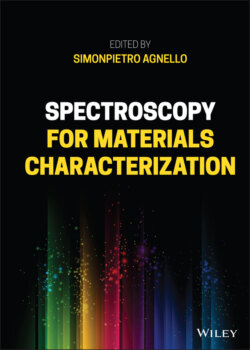Читать книгу Spectroscopy for Materials Characterization - Группа авторов - Страница 9
Оглавление
Preface
Ten years of experience in a basic laboratory course of spectroscopy for master’s students in physics as well as some courses for PhD students in physics and materials science together with more than 20 years of experimental work in physics and materials science convinced me of the opportunity to join the different basic aspects and technical approaches for the characterization of materials in a book. My contact with scientists in physics, chemistry, engineering, biology, and many other research fields emphasized the need to collect accurate and broad knowledge on spectroscopic techniques both from the fundamental point of view and from the technical perspective to impart the skills required to think about experiments, to interpret their results, and last but not least to advance theoretical knowledge. Motivated by these aspects, I started the project by inviting different experts in the various fields of spectroscopy, usually employed in the study of materials from the nanoscale up to the macroscopic scale and also in the field of astrophysics. In general, any atom, molecule, or condensed phase up to a solid needs to be characterized, from the species identification to structural definition and electron dynamics. Consequently, this practice‐oriented handbook collects the presentation of different spectroscopic techniques nowadays used to carry out experiments and is thought for master’s students, PhD students, and researchers who are not yet experts in the field of spectroscopy. Each chapter is a standalone contribution dedicated to a different technique and is composed of a basic theory introduction at a level adapted to students, plus more advanced information for experts. Then, details about the characteristic instrumental features and apparatus are considered, aiming to give hints for the appropriate arrangement of a typical experiment and, in some cases, for the understanding of the choice of an instrumental setup and the selection of technical features. Each chapter is completed by case studies that can be reproduced by employing commercially available or laboratory‐prepared samples, or by examples of applications mainly from the above‐cited fields of materials science, chemistry, and engineering. Furthermore, hints for the deepening one’s understanding of the topic with more specialist books are given along the way.
The first chapter is dedicated to the basic aspects of radiation–matter interaction in the visible‐ultraviolet range and the fundamentals of absorption and emission (fluorescence and phosphorescence) processes of atoms and molecules. This chapter is followed by two chapters on time‐resolved spectroscopy at the nanosecond scale and the more recent frontier approach of ultrafast spectroscopy at the femtosecond scale. These chapters detail the aspects of the electron dynamics in the excited states after pulsed excitation through emission and absorption processes including the Raman effect. Then, a chapter dedicated to fluorescence microscopy imaging at the nanoscale domain is presented with confocal and two‐photon techniques, where aspects of spatial resolution and dynamics are explored. The molecular vibrational spectroscopy in the infrared range is tackled in Chapters 5 and 6 by both the absorption and the Raman scattering effects. These chapters report on the fundamental aspects of radiation‐molecular vibration interaction and consider the traditional experimental methods, detailing the most recent applications of microscopy and joined vibrational–atomic force microscopy. The following two chapters consider spectroscopy related to irradiation effects. The first is focused on the thermoluminescence phenomenon of light emission induced by heating a sample after it has been exposed to ionizing radiation environment. The spectroscopic aspects are introduced and the basics of the phenomenon together with the interpretation of trap states and release thermodynamics are deepened in view of the application in many emerging fields such as dosimetry. In a similar context, Chapter 8 reports on the phenomena of radiation‐induced absorption, emission, and compaction with a focus on the novel online (in situ) measurements, particularly useful for the spectroscopic study of the materials' modifications during their exposure to ionizing radiation as well as their recovery processes. Chapters 9 and 10 treat the magnetic spectroscopy illustrating the electron and nuclear phenomena. In particular, electron paramagnetic resonance in the static and dynamic domains are dealt with in the former chapter, considering hyperfine interaction, transient dynamics, and the S = 1 state paramagnetism. In the latter chapter, the standard as well as the non‐conventional nuclear magnetic resonance phenomena are introduced including the Fourier transform, the Magic Angle Spinning, and the time domain studies. The book then reports on high‐energy spectroscopy with three chapters on X‐rays and ultraviolet radiation. Chapter 11 reports on the absorption process of X‐rays in near edge and pre‐edge, also including fine structure determination and in situ spectroscopy. Chapter 12 introduces photoelectron emission illustrating the surface maps and the depth and angle resolved profiles. Successively, Chapter 13 covers vacuum ultraviolet excitations considering the most widely available sources. Finally, two structural spectroscopy chapters on transmission electron spectroscopy (TEM) and atomic force microscopy (AFM) are included. They report on the structural investigation at the atomic and nanometric scale including those spectroscopic aspects pertaining to high‐energy excitation in the former technique and to the novel interpretation of spectroscopy in the latter.
The book, as stated above, is the result of the contribution of different scientists mainly working in the field of physics, chemistry, surface science, and nanoscience. Their different points of view assure a multidisciplinary approach to the techniques and, as a consequence, appeal to a broad readership of researchers and students dedicated to the studies on materials.
The Editor Simonpietro Agnello
